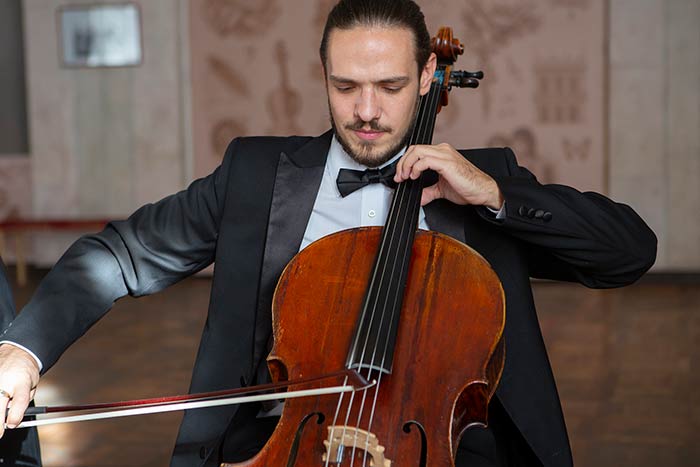The cello is one of the most beloved instruments in the orchestral world, celebrated for its rich, sonorous tones and huge emotional range.
When featured as a soloist within the context of an orchestra, the cello has the power to captivate listeners, evoking profound feelings of melancholy, triumph, and beauty.
Throughout history, composers have crafted unforgettable cello solos that highlight the instrument’s versatility, both technically and expressively.
With this in mind, let’s explore some of the most iconic cello solos in orchestral music, showcasing the unparalleled role of the cello in shaping the orchestral soundscape.
Antonín Dvořák – Cello Concerto in B minor, Op. 104
Arguably the most famous cello concerto in the classical repertoire, Dvořák’s Cello Concerto stands as a pinnacle of orchestral music.
Written in 1894, this concerto has become a central work for cellists, offering a perfect balance between lyrical expression and technical brilliance.
The first movement opens with a dramatic, sweeping theme, and the solo cello’s first entry immediately captures the audience’s attention.
The second movement is often considered one of the most beautiful cello solos ever written.
Its deeply emotive melody unfolds with poignant elegance, allowing the cellist to explore a wide range of dynamics and colours.
In the final movement, Dvořák brings the concerto to a thrilling conclusion, with the cello weaving through rich orchestral textures and playing a leading role in the music’s rhythmic drive.
Dvořák’s concerto stands out not only for its melodic beauty but also for the way it showcases the cello’s ability to blend seamlessly with the orchestra while maintaining its distinctive voice.
The dialogue between the cello and orchestra is masterful, with the cello at times becoming an intimate conversational partner with the other instruments and at other times soaring above the ensemble.
Joseph Haydn – Cello Concerto in C Major, Hob. VIIb/1
Haydn’s Cello Concerto is another monumental work in the cello canon.
Composed in 1761, the concerto was long forgotten until its rediscovery in 1961, but since then it has risen to become one of the most important pieces in the cello repertoire.
Haydn’s use of the cello as both a lyrical and virtuosic instrument shines throughout the piece, particularly in the opening movement, which features playful themes and impressive technical passages.
The Adagio movement is a serene, contemplative work that offers the soloist a chance to explore the cello’s expressive capabilities in depth, with long, singing lines that linger in the air.
The final movement is a joyous, exuberant conclusion to the concerto, marked by its buoyant themes and spirited dialogue between the cello and orchestra.
Haydn’s Cello Concerto is unique in that it was written during a time when the cello was not yet widely established as a prominent solo instrument.
In this concerto, Haydn elevated the cello to new heights, giving it a voice that was both technically demanding and profoundly expressive.
The piece remains a favourite among cellists, who revel in its blend of elegance and virtuosity.
Edward Elgar – Cello Concerto in E minor, Op. 85
Elgar’s Cello Concerto is perhaps one of the most poignant and introspective works ever written for the cello.
Composed in the aftermath of World War I, the concerto carries an air of melancholy, reflecting the sorrow and disillusionment of a world recovering from immense tragedy.
The opening movement begins with a hauntingly beautiful cello solo that slowly unravels, revealing the deep emotional gravity of the piece.
The cello’s voice is gentle yet powerful, and the dialogue between the soloist and the orchestra is intimate and subdued.
The second movement is marked by a wistful, longing theme that evokes a sense of quiet reflection.
In the final movement, the music seems to reach a catharsis though still tinged with sadness. Elgar’s Concerto is often viewed as a pinnacle of introspection, a profound meditation on loss and recovery.
The cello’s tone is central to the piece, serving as a vessel for the emotional depth and richness that Elgar so beautifully conveys.
The concerto has been immortalised by many iconic performances, most famously by Jacqueline du Pré, whose 1965 recording brought the piece to international acclaim.
The work remains a cornerstone of the cello repertoire, offering both performers and listeners a transformative emotional experience.
Camille Saint-Saëns – Cello Concerto No. 1 in A minor, Op. 33
Saint-Saëns’ Cello Concerto is a thrilling and virtuosic work that has become a favourite among cellists and audiences alike.
Composed in 1872, this concerto is known for its dazzling technical demands and vibrant orchestral colour. The first movement begins with a bold, dramatic theme introduced by the cello.
The soloist is then challenged with a series of rapid, virtuosic passages that highlight the cello’s agility and range.
The second movement is a lyrical and intimate interlude, offering the cellist a moment of respite with a beautiful, expressive melody.
The final movement is a lively and energetic conclusion that features intricate interplay between the cello and the orchestra, with both voices engaging in a spirited dialogue.
Saint-Saëns’ concerto stands out for its blend of technical brilliance and lyrical beauty.
The cello is at once a powerful soloist and an agile participant in the larger orchestral texture.
The concerto’s combination of virtuosic flair and expressive depth ensures its place as one of the most popular works in the cello repertoire.
Conclusion
The cello has long been a cornerstone of orchestral music, and its role as a soloist has led to the creation of some of the most beloved works in the classical repertoire.
From the sweeping lyricism of Dvořák to the haunting introspection of Elgar, these works showcase the cello’s extraordinary range, from powerful, virtuosic passages to tender, introspective melodies.
Whether it is in the form of dramatic intensity, intimate reflection, or exuberant celebration, the cello has proven to be an instrument capable of conveying the deepest emotions of the human experience, making these solos some of the finest examples of orchestral music in the classical tradition.







